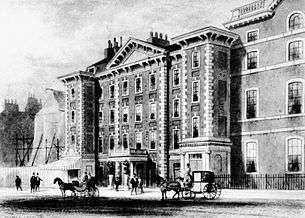Schomberg House
Coordinates: 51°30′21″N 0°8′9″W / 51.50583°N 0.13583°W

Schomberg House is a mansion on the south side of Pall Mall in central London which has a colourful history. Only the street facade survives today. It was built for The 3rd Duke of Schomberg, a Huguenot general in the service of the British Crown.[1] It was adapted from Portland House, which in turn has been created by the Countess of Portland by converting two houses into a single residence. Work began in 1694, the year after the duke inherited his title.
The street facade of Schomberg House is striking and rather unusual for a London mansion. It is of red brick, with four main storeys above the basement. The facade's street-level awning and decorative work is made of Lithodipyra (Coade stone) manufactured by Eleanor Coade. It is nine windows wide, with the central three bays projecting slightly and topped by a pediment, and the two end bays projecting boldly so that they form projections somewhat like small towers. The windows are narrow and six bold bands of quoins frame the three projections, giving the facade an energetic verticality.
Meinhardt Schomberg's dukedom became extinct on his death in 1719 and the house was subsequently let. In 1769 it was divided into three (80 Pall Mall to the west, 81 in the centre and 82 to the east) by the artist John Astley. Astley lived at no. 81 himself, and constructed a studio on the roof. In 1781 Astley was succeeded by a Scottish quack doctor called James Graham, who turned the establishment into a "Temple of Health and Hymen". The "Temple" featured a huge "celestial bed" fitted with early electrical devices, which was alleged to cure infertility, and was let to desperate and wealthy couples for £50 a night (about two years' wages for a labourer).

The Temple also served as a high-class brothel and gambling den, and was eventually raided by the police and closed down. Meanwhile, Thomas Gainsborough, who was at the height of his career as one of the two most fashionable portrait painters in England, lived next door at no. 80[2] from 1774 until his death in 1788. The artist Richard Cosway also lived at no. 81 for a time. During this period number 82 was a fashionable textile store.
In the first half of the 19th century Schomberg House was neither aristocratic nor artistic. The central house was a bookshop from 1804 to 1850, and other tenants of the three houses included a picture dealer, an auctioneer and a haberdasher. In 1850 no. 80 was demolished and replaced as part of an abortive redevelopment of the whole site. Then in 1859 nos. 80-82 were all acquired by the government for use by the War Office, which also occupied several other mansions in Pall Mall.
In 1956 the building was largely demolished to make way for offices. However, not only were the surviving facades of nos. 81 and 82 retained, but that of no. 80 was rebuilt in its original form. There have been further alterations since, and the interiors are now modern open plan offices, but the striking frontage remains.
The name Schomberg House has also been used for another property on Pall Mall that used to be the residence of Princess Christian of Schleswig-Holstein and later her two daughters. That property is now part of the Oxford and Cambridge Club (71 Pall Mall).
| Wikimedia Commons has media related to Schomberg House, Pall Mall, London. |
References
- ↑ "Schomberg House, Pall Mall, Westminster, Greater London". Heritage Explorer. Retrieved 13 May 2012.
- ↑ Plaque #2 on Open Plaques.